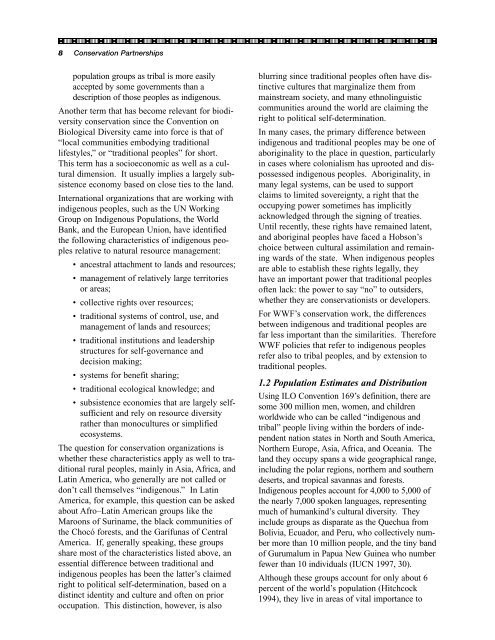Indigenous Peoples and Conservation Organizations
Indigenous Peoples and Conservation Organizations
Indigenous Peoples and Conservation Organizations
You also want an ePaper? Increase the reach of your titles
YUMPU automatically turns print PDFs into web optimized ePapers that Google loves.
8 <strong>Conservation</strong> Partnerships<br />
population groups as tribal is more easily<br />
accepted by some governments than a<br />
description of those peoples as indigenous.<br />
Another term that has become relevant for biodiversity<br />
conservation since the Convention on<br />
Biological Diversity came into force is that of<br />
“local communities embodying traditional<br />
lifestyles,” or “traditional peoples” for short.<br />
This term has a socioeconomic as well as a cultural<br />
dimension. It usually implies a largely subsistence<br />
economy based on close ties to the l<strong>and</strong>.<br />
International organizations that are working with<br />
indigenous peoples, such as the UN Working<br />
Group on <strong>Indigenous</strong> Populations, the World<br />
Bank, <strong>and</strong> the European Union, have identified<br />
the following characteristics of indigenous peoples<br />
relative to natural resource management:<br />
• ancestral attachment to l<strong>and</strong>s <strong>and</strong> resources;<br />
• management of relatively large territories<br />
or areas;<br />
• collective rights over resources;<br />
• traditional systems of control, use, <strong>and</strong><br />
management of l<strong>and</strong>s <strong>and</strong> resources;<br />
• traditional institutions <strong>and</strong> leadership<br />
structures for self-governance <strong>and</strong><br />
decision making;<br />
• systems for benefit sharing;<br />
• traditional ecological knowledge; <strong>and</strong><br />
• subsistence economies that are largely selfsufficient<br />
<strong>and</strong> rely on resource diversity<br />
rather than monocultures or simplified<br />
ecosystems.<br />
The question for conservation organizations is<br />
whether these characteristics apply as well to traditional<br />
rural peoples, mainly in Asia, Africa, <strong>and</strong><br />
Latin America, who generally are not called or<br />
don’t call themselves “indigenous.” In Latin<br />
America, for example, this question can be asked<br />
about Afro–Latin American groups like the<br />
Maroons of Suriname, the black communities of<br />
the Chocó forests, <strong>and</strong> the Garífunas of Central<br />
America. If, generally speaking, these groups<br />
share most of the characteristics listed above, an<br />
essential difference between traditional <strong>and</strong><br />
indigenous peoples has been the latter’s claimed<br />
right to political self-determination, based on a<br />
distinct identity <strong>and</strong> culture <strong>and</strong> often on prior<br />
occupation. This distinction, however, is also<br />
blurring since traditional peoples often have distinctive<br />
cultures that marginalize them from<br />
mainstream society, <strong>and</strong> many ethnolinguistic<br />
communities around the world are claiming the<br />
right to political self-determination.<br />
In many cases, the primary difference between<br />
indigenous <strong>and</strong> traditional peoples may be one of<br />
aboriginality to the place in question, particularly<br />
in cases where colonialism has uprooted <strong>and</strong> dispossessed<br />
indigenous peoples. Aboriginality, in<br />
many legal systems, can be used to support<br />
claims to limited sovereignty, a right that the<br />
occupying power sometimes has implicitly<br />
acknowledged through the signing of treaties.<br />
Until recently, these rights have remained latent,<br />
<strong>and</strong> aboriginal peoples have faced a Hobson’s<br />
choice between cultural assimilation <strong>and</strong> remaining<br />
wards of the state. When indigenous peoples<br />
are able to establish these rights legally, they<br />
have an important power that traditional peoples<br />
often lack: the power to say “no” to outsiders,<br />
whether they are conservationists or developers.<br />
For WWF’s conservation work, the differences<br />
between indigenous <strong>and</strong> traditional peoples are<br />
far less important than the similarities. Therefore<br />
WWF policies that refer to indigenous peoples<br />
refer also to tribal peoples, <strong>and</strong> by extension to<br />
traditional peoples.<br />
1.2 Population Estimates <strong>and</strong> Distribution<br />
Using ILO Convention 169’s definition, there are<br />
some 300 million men, women, <strong>and</strong> children<br />
worldwide who can be called “indigenous <strong>and</strong><br />
tribal” people living within the borders of independent<br />
nation states in North <strong>and</strong> South America,<br />
Northern Europe, Asia, Africa, <strong>and</strong> Oceania. The<br />
l<strong>and</strong> they occupy spans a wide geographical range,<br />
including the polar regions, northern <strong>and</strong> southern<br />
deserts, <strong>and</strong> tropical savannas <strong>and</strong> forests.<br />
<strong>Indigenous</strong> peoples account for 4,000 to 5,000 of<br />
the nearly 7,000 spoken languages, representing<br />
much of humankind’s cultural diversity. They<br />
include groups as disparate as the Quechua from<br />
Bolivia, Ecuador, <strong>and</strong> Peru, who collectively number<br />
more than 10 million people, <strong>and</strong> the tiny b<strong>and</strong><br />
of Gurumalum in Papua New Guinea who number<br />
fewer than 10 individuals (IUCN 1997, 30).<br />
Although these groups account for only about 6<br />
percent of the world’s population (Hitchcock<br />
1994), they live in areas of vital importance to

















